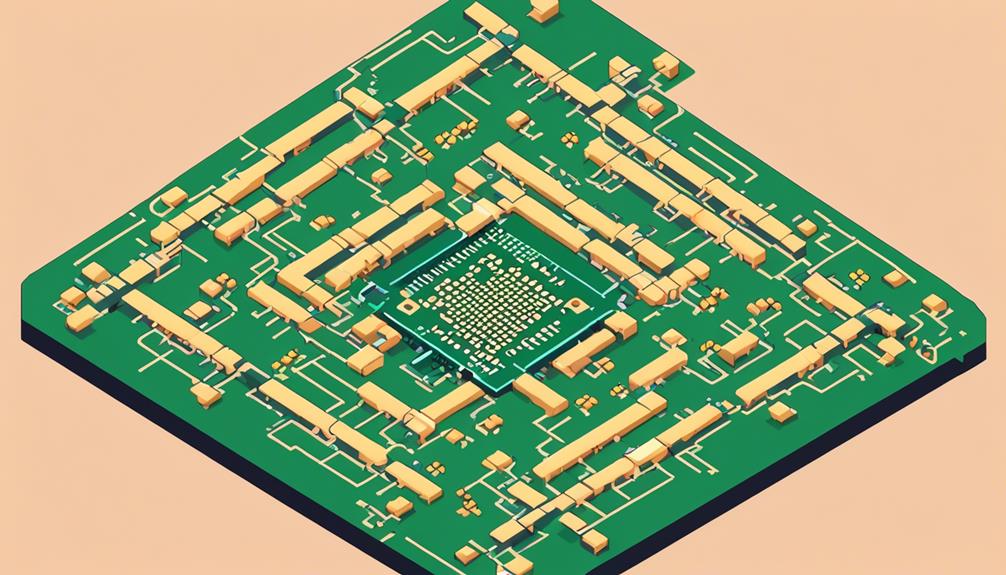Antennas play a crucial role in telecommunication, enabling the transmission and reception of signals that facilitate our interconnected world. From the ubiquitous monopole and dipole antennas to the sophisticated phased arrays, there is a wide range of antenna types designed to meet specific communication needs.
Each antenna design possesses unique characteristics, such as directivity, gain, and frequency response, which are carefully engineered to optimize signal propagation.
By understanding the various antenna types and their applications, we can delve into the fascinating world of antenna technology and explore their vital role in shaping our modern communication systems.
Key Takeaways
- Loop antennas are a type of antenna used in various telecommunication applications, such as AM broadcast receivers, radio direction finding systems, and wireless communication systems.
- Loop antennas have several advantages, including being less susceptible to noise and interference, easy installation and space-saving, directional radiation pattern for focused transmission and reception, and high efficiency in transmitting and receiving signals.
- Microstrip antennas, on the other hand, have considerations and performance characteristics such as substrate material and thickness, feeding mechanism selection, patch shape and dimensions, environmental factors, and substrate properties.
- Microstrip antennas offer advantages like high efficiency and low profile, the ability to tailor resonant frequency and radiation pattern, flow of electric current, wide frequency range, and ease of fabrication and integration with microwave circuits.
Monopole and Dipole

Monopole and dipole antennas are two distinct types of telecommunication antennas with specific physical structures and applications.
A dipole antenna consists of two long pieces of wire or metal tubing, forming a straight line but not connected to each other.
On the other hand, monopole antennas resemble dipoles but substitute a thin, flat conductor called a ground plane for one of the dipole's pieces.
Both monopole and dipole antennas find widespread use in telecommunication systems.
Mobile radios, such as those used in vehicles, commonly employ trunk- or roof-mounted monopole or dipole antennas. These antennas are designed to provide efficient transmission and reception of signals while minimizing interference.
Monopole antennas are also frequently used in portable devices such as pocket radios, portable phones, and walkie-talkies. Their compact size and ease of integration make them ideal for applications where space is limited.
The distinct physical structures of monopole and dipole antennas give them different properties and performance characteristics.
Dipole antennas, being symmetrical, radiate equal amounts of energy in all directions perpendicular to their axis. They are often used in applications where omnidirectional coverage is desired.
Monopole antennas, on the other hand, have a ground plane that acts as a mirror and enhances the radiation pattern in a specific direction. This makes them suitable for applications where directional coverage is required, such as in point-to-point communication systems.
Yagi
Yagi antennas, also known as Yagi-Uda antennas, are highly directional telecommunication antennas consisting of multiple metal tubing elements arranged parallel to each other on a backbone. These antennas are designed to boost the strength of incoming radio signals by reinforcing them with multiple metal tubing elements. Yagi antennas offer more directional sensitivity than dipole antennas and are aimed in the direction of the radio source. Engineers carefully select element lengths and spacing to optimize radio sensitivity in Yagi antennas. Due to their directional sensitivity, Yagi antennas are commonly used for TV reception.
To convey a deeper understanding of Yagi antennas, the following table provides a breakdown of the key components and their functions:
| Component | Description |
|---|---|
| Dipole | The first pair of elements acts as a traditional dipole, transmitting and receiving radio signals. |
| Director | Elements placed in front of the dipole, directing the radio waves towards the desired target. |
| Reflector | Elements placed behind the dipole, reflecting radio waves back towards the dipole for increased sensitivity. |
| Director | Additional elements placed in front of the dipole, further focusing the radio waves towards the target. |
| Director | More director elements can be added to enhance the directionality and gain of the antenna. |
The precise arrangement and dimensions of these elements play a crucial role in the performance of Yagi antennas. By optimizing the element lengths and spacing, engineers can achieve the desired level of directionality and gain.
Parabolic

Parabolic antennas, widely used in satellite TV receivers, radar installations, and radio telescopes, are highly effective in gathering and focusing radio waves into a small feed antenna. The curved parabolic surface of the antenna dish plays a critical role in gathering and focusing radio waves, and the larger the surface of the parabola, the greater the antenna's sensitivity.
Here are some key points about parabolic antennas:
- Amplification: Parabolic antennas are ideal for amplifying signals that have traveled over great distances. The curved shape of the parabola allows incoming waves to bounce off the surface and converge at a single point, known as the focus. This concentration of energy at the focus enhances the signal strength, making parabolic antennas suitable for long-range communication.
- Directionality: Parabolic antennas can be precisely aimed to transmit or receive signals in a specific direction. By adjusting the orientation of the dish, the antenna can focus on a particular satellite or point in space. This feature allows for efficient communication and reduces interference from unwanted signals.
- Applications: Parabolic antennas are essential components of communication devices on Earth. They are extensively used in satellite TV receivers to capture signals from satellites in geostationary orbit. Radar installations employ parabolic antennas to detect and track objects in the air, on land, or at sea. Furthermore, radio telescopes, such as the famous Arecibo Radio Telescope, utilize large-scale parabolic antennas to explore and study the universe.
Parabolic antennas play a vital role in telecommunication by efficiently gathering and focusing radio waves. Their ability to amplify signals, precise directional capabilities, and wide range of applications make them indispensable in various fields. Whether it's receiving satellite TV signals, tracking objects with radar, or discovering celestial phenomena with radio telescopes, parabolic antennas continue to shape the way we communicate and explore the world around us.
Horn
Horn antennas, commonly utilized in various applications such as police radar guns, microwave telecommunications gear, and garage door openers, are open-ended metal boxes with flared sides that prevent the reflection of microwave energy and efficiently collect and focus microwave energy for transmission and reception.
Horn antennas are an essential component in microwave telecommunications gear due to their ability to transmit and receive radio waves effectively. The design of a horn antenna consists of an open-ended metal box with flared sides that prevent the reflection of microwave energy. This prevents interference and ensures efficient transmission of radio waves.
When used for transmitting, the flared sides of the horn antenna prevent the microwave energy from reflecting back into the antenna, ensuring that the energy is directed outward. This allows for increased coverage and reduces signal loss. The open-ended design also enables the antenna to collect and focus microwave energy, enhancing the range and strength of the transmitted signal.
In receiving applications, the horn antenna efficiently collects and focuses incoming microwave energy. The flared sides prevent the energy from scattering, allowing for precise reception of radio waves. This makes horn antennas particularly suitable for applications such as police radar guns and garage door openers, where accurate detection and reception are crucial.
The construction of horn antennas is typically made from metal, such as aluminum or brass, which provides durability and stability. The size and shape of the flared sides can vary depending on the desired frequency range and application.
Loop

Loop antennas are a type of antenna that consists of a simple wire loop or coil.
There are various types of loop antennas, including the circular loop and more complex shapes, which can be designed to optimize performance for specific applications.
Loop antennas find widespread use in AM radio receivers and metal detectors due to their compact size, efficiency, good selectivity, and reduced sensitivity to noise compared to other antenna types.
Loop Antenna Types
Loop antennas are a vital component in telecommunication systems as they offer a range of types specifically designed to suit different applications and frequencies. Understanding the different types of loop antennas is crucial in optimizing signal strength and minimizing interference.
Here are some common loop antenna types:
- Magnetic Loop Antenna: Utilizes a loop of wire to receive electromagnetic waves and is effective in reducing interference.
- Electrically Small Loop Antenna: Compact in size, it is suitable for portable devices and has a limited radiation efficiency due to its small size.
- Resonant Loop Antenna: Operates at a specific frequency, resonating to the incoming signal, and can be used for both transmission and reception.
- Ferrite Loop Antenna: Contains a ferrite core to enhance its magnetic properties, commonly found in AM radios and portable devices.
- Multi-Turn Loop Antenna: Consists of multiple loops of wire wound around a core, increasing its inductance and enhancing its performance in certain frequency ranges.
Each of these loop antenna types has its own advantages and applications, allowing telecommunication systems to efficiently transmit and receive signals with optimal signal strength.
Loop Antenna Applications
Loop antennas are widely utilized in various applications within the field of telecommunication due to their efficiency and compact size.
One of the different applications of loop antennas is in AM broadcast receivers. Their ability to efficiently pick up AM radio signals makes them ideal for this purpose.
Additionally, loop antennas are used in radio direction finding systems, where their directional properties are exploited to determine the direction of a radio source.
In radio frequency identification (RFID) systems, loop antennas are employed for tracking and identification purposes. Due to their compact size, loop antennas are commonly used in portable devices such as handheld radios and walkie-talkies.
In certain scenarios, loop antennas are also used in wireless communication systems to enhance signal reception, especially when there is a need to use parabolic antennas or a ground plane is not feasible.
Loop Antenna Advantages
The efficiency and compact size of loop antennas make them highly advantageous for various applications in the field of telecommunication.
Here are the advantages of loop antennas:
- Less susceptible to noise and interference: Loop antennas are designed to minimize the effects of noise and interference, making them ideal for improving signal quality in crowded environments.
- Easy installation and space-saving: Their compact size and simple design allow for easy installation and make them suitable for space-constrained applications.
- Directional radiation pattern: Loop antennas have a directional radiation pattern, enabling focused transmission and reception of signals in a specific direction.
- High efficiency: Loop antennas exhibit high efficiency in transmitting and receiving signals, contributing to reliable and consistent communication performance.
- Versatility: Loop antennas can be used for various applications, including AM broadcast reception, radio direction finding, and RFID systems.
These advantages make loop antennas a popular choice in telecommunication, enabling efficient and reliable communication in diverse scenarios.
Microstrip

Microstrip antennas are widely used in telecommunication due to their unique design considerations, performance characteristics, and various applications.
When designing a microstrip antenna, factors such as substrate material, patch shape, and feeding technique must be carefully considered to achieve the desired performance.
The performance characteristics of microstrip antennas include radiation pattern, gain, bandwidth, and efficiency, which are crucial in determining their suitability for specific applications.
Although microstrip antennas offer advantages such as low profile and easy integration, they also have limitations, including narrow bandwidth and sensitivity to substrate properties, which must be taken into account during the design process.
Design Considerations
Careful consideration of substrate material and thickness is essential in achieving the desired performance of microstrip antennas in telecommunication. The choice of substrate material greatly affects the antenna's characteristics, such as impedance matching, bandwidth, and efficiency. Additionally, the substrate thickness influences the size and shape of the antenna.
Design considerations for microstrip antennas also include the feeding mechanism. The selection of microstrip line or coaxial probe affects the impedance and radiation pattern of the antenna.
Furthermore, the shape and dimensions of the patch, as well as the ground plane, play a crucial role in determining the antenna's radiation pattern and bandwidth.
Environmental factors, such as temperature and humidity, should not be neglected during the design process as they can impact the performance of microstrip antennas.
Performance Characteristics
With their high efficiency and low profile, microstrip antennas offer a versatile and cost-effective solution for compact and integrated telecommunication applications. These antennas are often used in wireless communication systems, satellite communication, and radar systems due to their desirable performance characteristics.
The performance of microstrip antennas is influenced by various factors, including their dimensions and the substrate material used. By adjusting these parameters, the antenna's resonant frequency and radiation pattern can be tailored to meet specific requirements.
Microstrip antennas operate by the flow of electric current along the conductive patch on a dielectric substrate. As the waves travel along the microstrip transmission line, they are radiated into space, allowing for efficient transmission and reception of signals.
The frequency range of microstrip antennas depends on the size of the patch and the dielectric constant of the substrate material.
The ease of fabrication and integration with microwave circuits further contributes to the cost-effectiveness and versatility of microstrip antennas in telecommunication applications.
Applications and Limitations
Aerospace and wireless communication applications benefit from the lightweight and compact design of microstrip antennas. These antennas have found widespread use in various devices and systems.
Some of the applications of microstrip antennas are as follows:
- In aerospace applications, microstrip antennas are used in aircraft and satellite communication systems due to their small form factor and ease of integration.
- They are commonly used in wireless communication devices such as mobile phones, Wi-Fi routers, and Bluetooth devices, enabling seamless connectivity.
However, microstrip antennas also have some limitations:
- Microstrip antennas are generally narrowband, which restricts their use in applications requiring wide frequency coverage, such as FM radio or video conferencing.
- They have limitations in terms of power handling capability, making them less suitable for high-power transmission applications like radio stations.
- Designing microstrip antennas for high efficiency and radiation performance can be challenging, especially at lower frequencies, which may limit their applicability in certain communication systems.
Log-periodic

Log-periodic antennas, known for their ability to support a broad range of frequencies while maintaining consistent performance, are widely used in directional applications such as radio and television broadcasting, as well as in wireless communication systems. These antennas have multiple elements and are designed to exhibit consistent performance over a wide frequency range. One of the key advantages of log-periodic antennas is their ability to maintain a constant impedance and radiation pattern across their frequency range.
The log-periodic antenna is characterized by its logarithmic periodicity, which means that the size and spacing of its elements increase logarithmically from the smallest element to the largest. This unique design allows the antenna to operate over a wide range of frequencies. The elements of the log-periodic antenna are specifically designed to be self-similar, meaning that the shape and pattern of the elements are repeated at different scales. This self-similarity ensures that the antenna maintains its performance characteristics across the entire frequency range.
The log-periodic antenna can both receive and transmit signals. It is commonly used in applications where a single antenna needs to cover a wide range of frequencies. For example, in radio and television broadcasting, log-periodic antennas are used to transmit and receive signals across multiple channels. In wireless communication systems, log-periodic antennas are used to provide coverage for various frequency bands, allowing for efficient communication over a wide range of frequencies.
Patch
The patch antenna, a type of directional antenna with a flat, rectangular shape, is commonly utilized in wireless communication systems due to its high gain, low profile, and ease of integration. These antennas are used in a variety of applications, ranging from wireless routers to GPS devices and satellite communication systems.
The key features and benefits of patch antennas are as follows:
- Compact Design:
Patch antennas are typically made from a flat metal patch on top of a dielectric substrate. This compact design allows for easy integration into various devices, making them suitable for applications where space is limited.
- Operating Frequency:
Patch antennas can be designed to operate at specific frequencies, such as WiFi, Bluetooth, and cellular bands. This flexibility allows for a wide range of wireless communication applications, ensuring compatibility with different devices and systems.
- Signal Reception:
The patch antenna receives signals from a transmitter, which sends electromagnetic waves at a specific frequency. The directional nature of the patch antenna allows for focused reception of signals, resulting in improved signal strength and quality.
- Beamforming and Directional Transmission:
Patch antennas are often used in phased array antenna systems to achieve beamforming and directional signal transmission. By carefully controlling the phase and amplitude of the signals across multiple patch antennas, the overall system can transmit signals in specific directions, improving communication range and reliability.
Phased Array

How does the phased array antenna system utilize multiple antennas to achieve directive beam control?
A phased array antenna system consists of several antennas used to transmit or receive signals. By controlling the phase of the signals at each antenna element, the system can electronically steer the beam in different directions without physically moving the antenna. This capability allows for rapid and precise adjustments to the beam, enabling the antenna to dynamically adapt to changing signal environments.
In a phased array system, the incoming radio signals are divided into multiple parts and fed to each antenna element with a specific phase shift. The phase shift determines the direction in which the signal is transmitted or received. By adjusting the phase shifts across the antennas, the system can create constructive or destructive interference, resulting in a directive beam focused in a particular direction.
The phased array technology offers various benefits over traditional fixed antennas. It provides improved spatial coverage, as the beam can be steered in different directions to cover a larger area. Moreover, it allows for reduced interference, as the beam can be directed away from sources of interference. Additionally, phased array antennas offer enhanced signal reception and transmission capabilities, as the beam can be electronically scanned to track moving targets or adapt to changing signal conditions.
Phased array antennas find applications in radar systems, communication systems, and wireless networks. The ability to electronically steer the beam without physically moving the antenna provides greater flexibility and enables advanced features such as beamforming and beam steering. Overall, the phased array antenna system offers a powerful solution for achieving directive beam control in telecommunication applications.
Frequently Asked Questions
What Are the Antennas Used in Telecommunication?
Antennas play a vital role in telecommunication by facilitating the transmission and reception of electromagnetic signals. Antenna technology advancements have led to the evolution of antennas in telecommunication, with a focus on improving performance and design considerations.
Antennas used in telecommunication are designed to meet specific requirements such as gain, radiation pattern, and frequency range. Antenna performance evaluation is crucial to ensure optimal signal reception and transmission.
What Are the 3 Basic Types of Antennas?
There are three basic types of antennas: dipole, monopole, and loop antennas.
Dipole antennas consist of two conductive elements that are symmetrically arranged and are widely used due to their omnidirectional radiation pattern.
Monopole antennas are half of a dipole antenna and are commonly used in radio and TV broadcasting.
Loop antennas are made of a loop of wire and are often used in portable devices due to their compact size and efficiency in capturing radio signals.
What Is the Purpose of Antenna in Communication?
The purpose of antennas in communication is to enable the transmission and reception of electromagnetic waves. They play a vital role in wireless communication by capturing and amplifying radio signals, extending signal range, and facilitating the conversion of electric current into electromagnetic waves.
Antennas are designed to meet specific requirements based on their structure, frequency range, impedance, and gain. Their importance in communication cannot be overstated, as they enable the efficient and reliable transfer of information in various applications such as broadcasting, cellular communications, satellite communications, and radar systems.
What Type of Antennas Are Used in Cellular Communication?
Different types of antennas are used in cellular communication to ensure efficient signal transmission and reception. Antenna design considerations include frequency range, gain, radiation pattern, and polarization. Antenna performance metrics such as efficiency, bandwidth, and impedance matching are crucial for optimal communication.
Antennas in wireless networks play a vital role in enabling reliable and high-quality wireless connections for voice, data, and multimedia services. The selection of antennas depends on factors like coverage requirements, network topology, and the desired signal propagation characteristics.

